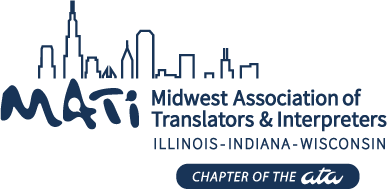Naming a “New” Reality: Span-USism
By Alejandra Patricia Karamanian
For last year's words belong to last year's language
And next year's words await another voice
T.S. Eliot
Spanish is no longer a candidate. The word “candidate” comes from Latin candidatus, meaning “white,” and makes reference to ancient Roma, where those running for public office wore a white toga. The Spanish language has already taken off its toga to become one of the most used and studied languages worldwide. It is not surprising, then, that English to Spanish translators are increasingly interested in U.S. Spanish with its popular language on one hand, and its academic language, on the other.
In Spanish, we have the term estadounidismo to describe the words or phrases born out of the two languages in contact in the United States—English and Spanish. Inserted in a formal socio-cultural-language communication situation, these words or phrases (a) are fully Spanish as they meet the word-formation requirements while bearing the U.S. English language and cultural stamp, and (b) already exist in the Spanish language but now with a new meaning. Examples: Departamento (as a public entity), paralegal, elegible, copago, to name but a few.
Languages are constantly picking up neologisms to name new realities, and this is not the exception to the rule. In Spanish, the suffix –ismo equals –ism in English with the meaning of “indicating a characteristic usage, esp. of a language” (https://www.collinsdictionary.com/dictionary/english/ism_2), and thus forming argentinismo, chilenismo, colombianismo, and a long list of -ismos belonging to the 23 varieties of Spanish spoken in the world. The good news is that the 23rd edition of Diccionario de la Lengua Española has included estadoundismo. By the way, the English dictionaries list words like Italianism, Gallicism, Briticism, Hellenism, etc., but not any –ism for the –ismos listed above.
At this point, my question was what English term would stand for estadounidismo. Browsing dictionaries, I found the following words that describe foreign words that initially seem to fit our search: Anglicism, Americanism, Anglo-Americanism. But when we compare them to their Spanish counterparts anglicismo, americanismo, and angloamericanismo, something is missing.
Let’s look at some definitions of these terms in English dictionaries:
Merriam Webster: Anglicism
1: a characteristic feature of English occurring in another language
2: adherence or attachment to English customs or ideas
Origin and Etymology of Anglicism
Medieval Latin anglicus English
First Known Use: 1642
Other dictionaries also show that this definition doesn’t incorporate the meaning of estadounidismo: See Oxford Dictionaries and Wikipedia.
Merriam Webster: Americanism
1: a characteristic feature of American English especially as contrasted with British English
2: attachment or allegiance to the traditions, interests, or ideals of the U.S.
3: a: a custom or trait peculiar to America
b: the political principles and practices essential to American culture
The Oxford Dictionary definition for Americanism also does not include our desired definition.
Oxford Dictionaries: Anglo-Americanism
1. A characteristically American English word, phrase, or idiom, (now especially) one borrowed into another language.
2. Cooperation or integration between England (or Britain) and America; allegiance to or advocacy of this.
a. anglicismo
b. americanismo
c. angloamericanismo
Origin: Early 19th century; earliest use found in Christian Observer. From Anglo-American + -ism.
Along these lines, the translation of these three terms, Anglicism, Americanism, and Anglo-Americanism do not represent the full diglossic reality of an estadounidismo. Let’s make a proof to sustain this hypothesis by translating them back and looking up their definitions in Diccionario de la Lengua Española: anglicismo, americanismo, angloamericanismo.
a. anglicismo
De ánglico e -ismo.
1. m. Giro o modo de hablar propio de la lengua inglesa.
2. m. Vocablo o giro de la lengua inglesa empleado en otra.
3. m. Empleo de vocablos o giros ingleses en distintos idiomas.
b. americanismo
1. m. Cualidad o condición de americano.
2. m. Carácter genuinamente americano.
3. m. Amor o apego a lo americano.
4. m. americanística.
5. m. Vocablo, giro o rasgo fonético, gramatical o semántico que pertenece a alguna lengua indígena de América o proviene de ella.
6. m. Vocablo, giro o rasgo fonético, gramatical o semántico peculiar o procedente del español hablado en algún país de América.
c. angloamericanismo.
De angloamericano e -ismo.
1. m. Vocablo, giro o rasgo fonético, gramatical o semántico peculiar o procedente del ingléshablado en los Estados Unidos de América.
And now our star today and the definition included in the same dictionary:
estadounidismo
1. m. Palabra o uso propios del español hablado en los Estados Unidos de América.
At this crossroad, it is clear that neither Anglicism, nor Americanism or Anglo-Americanism can faithfully stand for our estadounidismo because none of definitions include its specific meaning.
With the goal of creating a neologism revealing the “new” socio-culture-language reality as well as incorporating “a word or use proper to U.S. Spanish,” I would propose translating estadounidismo using blending, which is one method of word formation, creating the blend or composite acronym: Span-USism.
Proposals of definitions for dictionaries’ entries:
Span-USism
1. a characteristic feature of the U.S. Spanish language.
2. a word, phrase or construction that is peculiar to the Spanish spoken in the United States of America.
3. a word, phrase or construction peculiar to the U.S. Spanish language.
Footnote: After all this analysis, it is worth noting that, unfortunately, just 6 estadounidismos have been included in the 23rd issue of Diccionario de la Lengua Española: billón, congresional, guardavidas, sobador, trillón, and last but not least estadounidismo, of course! A long way to go…
---
Alejandra Patricia Karamanian is a Certified Sworn Translator, Copy Editor and Proofreader of the Spanish Language, and holds an M.A. in Teaching Spanish for Foreigners. She is an independent translator in legal, business, and international relations fields; online/onsite teacher at translation for national and international associations of translators, the New York University, and online Spanish courses for foreigners. She is a member of the North American Academy of the Spanish Language (ANLE). Languages: Spanish, English, French. Contact: apk@apktranslation.com, alejandrapatricia1717@gmail.com or www.apktranslation.com
 on Blog
on Blog